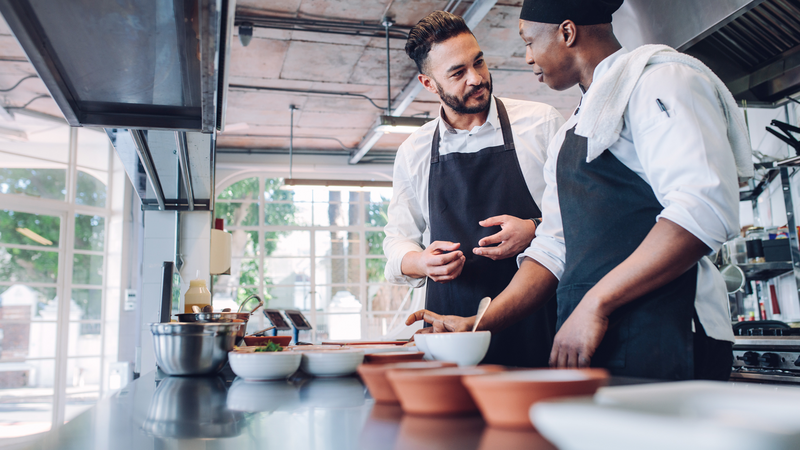Summer has finally arrived, and for many, this means hosting friends and family for cookouts or other food-focused gatherings. While commercial kitchens maintain a rigorous focus on food safety, following a few basic guidelines in your home kitchen can help protect you and your loved ones from foodborne illness and keep everyone happy and healthy as you enjoy the warmer months.
In honor of World Food Safety Day, we’re providing some simple recommendations and good habits to keep your home kitchen a safe and hygienic place to share the joy of cooking with the people you care about.
1. Cleanliness is Crucial
Clean kitchens are the foundation of food safety. Prior to any food preparation be sure all countertops, cooking utensils, and cutting boards have been cleaned with soapy water (before and after each use) and that you regularly wash your hands—also with soap and potable water—for at least 20 seconds. Especially when handling raw meat, seafood, or poultry, it’s important to be diligent, as uncooked proteins can be a haven for harmful bacteria. Washing and rewashing your hands, tools, and cutting boards may feel tedious, but it’s one of the best ways to avoid contaminating food.
“Even with a clean kitchen, there are some basics at-home cooks may not consider,” says Peter Rukule, Vice President of Culinary for ISS Guckenheimer. “For example, someone may rinse chicken or beef and then later wash produce without cleaning the sink first, not thinking about the cross-contamination that just occurred. People might feel like constantly cleaning your knives, cutting boards, or sink is a bit eccentric in a home kitchen, but it really goes a long way in terms of preventing foodborne illness, especially for young kids, elderly adults, and people with weaker immune systems.”
2. Avoid Cross-Contamination
Cross-contamination, or the transfer of microorganisms to other foods or surfaces, is one of the primary sources of food-related illness. As a result, it’s important to be mindful of how you store, prepare, and handle all items. One chef-recommended strategy to mitigate cross-contamination is the use of color-coded cutting boards dedicated to specific foods.
“Some basics are red for raw meat, yellow for poultry, green for vegetables, and white for prepared foods,” says Thomas Provost, a Guckenheimer executive chef based in the Boston area. “But even if you don’t use a color-coordinated system, having separate cutting boards for different items is a good habit for home cooks to get into to avoid cross-contaminating their food.”
Prepare everything one at a time and keep finished items away from raw or unwashed foods. Even something as simple as using the same towel to dry your hands can introduce unwanted pathogens into food, so do your best to avoid cross-contamination and keep your cooking area sanitary. Improper food storage can also be a source of cross-contamination. For example, raw meat stored on high shelves can drip onto lower items in your fridge, leaving harmful bacteria on foods or surfaces that otherwise appear clean.
3. Pay Attention to Temperatures
Monitoring the temperature of food is one of the most important aspects of ensuring its safety. Especially when food is left out, bacteria can grow to unsafe levels quickly when in the “danger zone”—40 °F to 140 °F (or 4 °C to 60 °C)—so keep cold items in the refrigerator and hot items in a warming tray or slow cooker.
“I have this conversation a lot with my friends and family because they tend to toss frozen meat in the sink to defrost while they’re at work, which can put it in the danger zone for multiple hours,” Rukule says. “It can be a hard habit to break—my 80-year-old mother is notorious for this!” (He recommends thawing in the fridge overnight).
When cooking meat, don’t just use your eyes to determine if something is done. Using a thermometer can help you find the right internal temperature to avoid undercooking your food or scorching it beyond recognition—be sure to sanitize the thermometer when you’re done.
Transporting food may also present challenges. Traveling with cold items in a cooler is a simple solution, but hot items may require reheating at your destination to keep it safe to eat. Regardless, don’t let items sit out too long at room temperature.
4. Use the Right Tools for the Job
In addition to avoiding pathogens, safety in the kitchen also requires some knowledge of sharp tools like knives or mandoline slicers. Learning which knife to use not only helps you prepare your food more effectively, but also prevents injuries. For example, using a tiny paring knife to cut a watermelon might be both tedious and harmful; cut-resistant gloves also provide some protection against accidental injuries.
It’s relatively easy and inexpensive to boost your skills with kitchen tools. Explore YouTube for new knife techniques or read articles written by chefs to learn more about food preparation and kitchen safety. These efforts will help you become a better home cook while also keeping yourself and loved ones safer in the process.
Food safety is a responsibility we all share. By putting in extra effort and making safe practices a part of our cooking routine, we can make better meals and safeguard the health and well-being of others.
